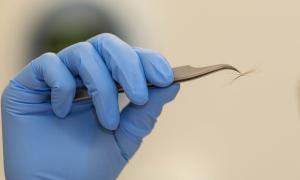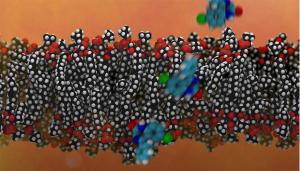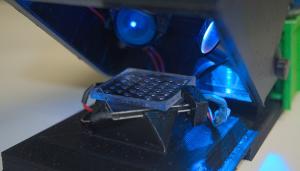LAB REPORT
Science and Technology Making Headlines
April 28, 2017


Glendon Parker, a biochemist with LLNL’s Forensic Science Center, examines a 250-year-old archaeological hair sample that has been analyzed for human identification using protein markers from the hair. Photo by Julie Russell/LLNL.
The mane ingredient in forensics
The world of forensics is becoming more and more like the crime scene drama “CSI.”
Lawrence Livermore researchers are playing a role in the advancement of forensic technology.
Unlike the DNA in mixed samples, strands of hair can be separated easily from one another, and a new approach is using hair for protein-based identification.
“With hair, we’re still looking at DNA, but we’re just looking at it in a radically different way, and that’s in terms of the signatures it leaves in proteins,” says Glendon Parker, who was a biochemist at Lawrence National Laboratory’s Forensic Science Center, where the technique was developed.
Research groups at LLNL and the startup company Protein-Based Identification Technologies of Orem, Utah, are developing the approach, which centers on a class of DNA mutations that result in sequence changes within hair proteins. “In a way, we’re doing DNA typing, but we’re doing it by looking at the ‘fingerprints’ that DNA has in proteins, and then using those ‘fingerprints’ to predict back to that DNA,” Parker said.

During the 1950s and '60s, duck and cover drills were common in classrooms. Bettmann/Getty Images
Go inside, stay inside
Some leading emergency response planners view the persistent menace of North Korea as a new opportunity: reason to alert the American public that a limited nuclear attack can be survivable, with a few precautions.
The simplest of the warnings is: “Don't run. Get inside.” Sheltering in place, beneath as many layers of protection as possible, is the best way to avoid the radiation that would follow a nuclear detonation.
That conclusion has been the consensus of emergency responders for years, though there has been a hesitance to spread the word.
Brooke Buddemeier, a nationally recognized expert on nuclear disaster preparedness from Lawrence Livermore National Laboratory, said that following the 9/11 attacks, Americans may have suffered a kind of "preparedness fatigue."
“There was so much information that came out altogether,” Buddemeier said, “but then it's kind of hard to fit information about nuclear terrorism in with warnings about earthquakes and hurricanes and wildfires and all other emergencies that happen on a regular basis.”


Drug molecules (cyan) pass through a cell membrane that simulates the blood-brain barrier. Composite graphic: Tim Carpenter/LLNL
Hitting the disease on target
Lawrence Livermore scientists are modeling the blood-brain barrier to find ways for drugs to reach their target.
New laboratory-crafted medications to treat stroke, Alzheimer’s disease and other medical conditions that attack the brain are not very effective because not enough of the drug moves out of the blood stream and into the brain.
Tim Carpenter, an LLNL computational biophysicist, has developed a computer model to examine barrier permeability. Simulations using the model agree with those experiments, and the group uses the calculations to check whether hypothetical compounds are permeable before they’re synthesized. The models help determine which potential drugs may be worth the effort and expense to develop further.
Drugs that cross the barrier could advance treatment of many other serious conditions besides stroke and Alzheimer’s disease, including brain or spinal cord injury, autism, ALS, AIDS and Huntington’s disease.


A global map of antineutrino emissions illustrates that many of the wispy particles are released from Earth’s crust and nuclear reactors.
Watch out for nuclear ghosts
Weapons-grade fuel in a nuclear reactor emits a steady rate of telltale antineutrinos that could be detected by a newly designed portable device.
All nuclear reactors emit radiation and antineutrinos. While radiation can be blocked with a few feet of soil or concrete, antineutrinos pass unimpeded through hundreds of miles of solid Earth.
That antineutrino is the “tell” for a reactor because only the radioactive elements in nuclear fuel emit lots of them at a steady rate.
Los Alamos and Lawrence Livermore national laboratories have developed the WATCHMAN (for WATer CHerenkov Monitor for ANtineutrinos) to track antineutrinos. A WATCHMAN device would consist of a tank containing thousands of tons of gadolinium-doped water and could theoretically detect antineutrinos from an illicit reactor up to 1,000 kilometers away.
But LANL’s Patrick Jaffke and LLNL’s Steven Dazeley have proposed that a small version could be placed close to a reactor to determine the type of nuclear fuel within by analyzing the activity of antineutrinos.

An LLNL and University of Wisconsin, Madison, research team developed a diagnostic kit that is low-cost, portable, easy to use and can diagnose in about one hour. Photo by Kate Hunts/LLNL
The whole kit and caboodle in a shoebox
The rise of anti-bacterial resistance has been a considerable concern for health care providers around the world in recent years, and finding the right treatment plans for patients with this resistance is both costly and time-consuming. This is especially challenging in remote conditions where access to the lab conditions required for bacterial identification is impossible.
Lawrence Livermore scientists have created a shoebox-size portable kit that is low-cost and low-energy to run. It requires a 9 volt battery with a B-chip (bacteria-detection chip) reader performing the recombinase polymerase amplification (RPA). The entire process can be done in under an hour.
The chip contains a disposable plastic assay cartridge that can assess up to 16 different diseases at any one time. De-gassed samples are pumped into the inlet, with air then added to physically separate the reactions and prevent cross contamination.





